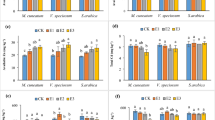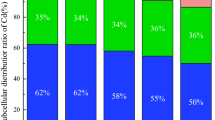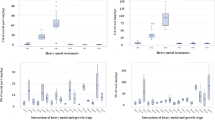Abstract
Artemisia vulgaris (mugwort) is a tall (1.0–2.0 m) high biomass perennial herb which accumulates considerable amounts of metals on contaminated sites. An outdoor pot experiment was conducted on a sandy, slightly alkaline soil of moderate fertility to study the uptake of cadmium and the distribution of Cd in plant tissues of A. vulgaris. Cadmium was applied as CdCl2 (a total of 1 l solution of 0, 10, 50 and 100 mg Cd l−1) to 12-l pots with a height of 25 cm. HNO3- and water-extractable concentrations of Cd were correlated with the applied Cd at 2-cm soil depth, but were not correlated at 20-cm soil depth, suggesting that Cd was either not mobile in the soil or completely taken up by mugwort roots. The Cd concentrations in different organs of A. vulgaris and litter increased with increasing soil contamination. Leaf/soil concentration ratios (BCFs) up to 65.93 ± 32.26 were observed. Translocation of Cd to the aboveground organs was very high. The leaf/root Cd concentration ratio (translocation factor) ranged from 2.07 ± 0.56 to 2.37 ± 1.31; however, there was no correlation of translocation factors to Cd enrichment, indicating similar translocation upon different soil contamination levels. In summary, A. vulgaris is tolerant to the metal concentrations accumulated, has a high metal accumulating biomass and accumulates Cd up to about 70% in the aboveground parts. Both a high phytoextraction potential and a high value for phytostabilisation would recommend mugwort for phytoremediation.

Similar content being viewed by others
References
Alloway, B. J. (1995). Heavy metals in soils (2nd ed.). Glasgow: Blackie Academic and Professional.
Álvarez-Ayuso, E. (2008). Cadmium in soil–plant systems: an overview. International Journal of Environment and Pollution, 33, 275–291.
Baker, A. J. M. (1981). Accumulators and excluders—Strategies in the response of plants to heavy metals. Journal of Plant Nutrition, 3, 643–654.
Baker, A. J. M., & Brooks, R. R. (1989). Terrestrial higher plants which can hyperaccumulate metallic elements—A review of their distribution, ecology and phytochemistry. Biorecovery, 1, 81–126.
Baker, A. J. M., & Proctor, J. (1990). The influence of cadmium, copper, lead, and zinc on the distribution and evolution of metallophytes in the British Isles. Plant Systematics and Evolution, 173, 91–108.
Baker, A. J. M., & Whiting, S. N. (2002). In search of the Holy Grail—A further step in understanding metal hyperaccumulation? The New Phytologist, 155, 1–4.
Barney, J. N., & DiTommaso, A. (2003). The biology of Canadian weeds. 118. Artemisia vulgaris L. Canadian Journal of Plant Science, 83, 205–215.
Blume, H. P. (1981). Schwermetallverteilung und-bilanzen typischer Waldböden aus nordischem Geschiebemergel. Zeitschrift für Pflanzenernährung und Bodenkunde, 144, 156–163.
Chaney, R. L. (1983). Plant uptake of inorganic waste constituents. In J. F. Parr, P. B. Marsh, & J. M. Kla (Eds.), Land treatment of hazardous waste (pp. 50–76). Parkridge: Noyes Data Corporation.
Dahmani-Muller, H., van Oort, F., Gélie, B., & Balabane, M. (2000). Strategies of heavy metal uptake by three plant species growing near a metal smelter. Environmental Pollution, 109, 231–238.
Dickinson, N. M., Baker, A. J. M., Doronila, A., Laidlaw, S., & Reeves, R. D. (2009). Phytoremediation of inorganics: Realism and synergies. International Journal of Phytoremediation, 11, 97–114.
Duvigneaud, P. (1975). Structure, biomasses, minéralomasses, productivité et captation du plomb dans quelques associations rudérales (Artemisietalia vulgaris). Bulletin de la Société Royale de Botaniquie Belgique, 108, 93–128.
Ernst, W. H. O. (2000). Evolution of metal hyperaccumulation and phytoremediation hype. The New Phytologist, 146, 357–358.
Ernst, W. H. O., Mathys, W., Salaske, J., & Janiesch, P. (1974). Aspekte von Schwermetallbelastungen in Westfalen. Abhandlungen des Landesmuseums für Naturkunde Münster, 36(2), 1–33.
Govindaraj, S., Kumari, B. D. R., Cioni, P. L., & Flamini, G. (2008). Mass propagation and essential oil analysis of Artemisia vulgaris. Journal of Bioscience and Bioengineering, 105, 176–183.
Grime, J. P., Hodgson, J. G., & Hunt, R. (1988). Comparative plant ecology. London: Unwin Hyman.
Hunter, B. A., Johnson, M. S., & Thompson, D. J. (1987). Ecotoxicology of copper and cadmium in a contaminated grassland ecosystem. Journal of Applied Ecology, 24, 573–586.
Jensen, J. K., Holm, P. E., Nejrup, J., Larsen, M. B., & Borggaard, O. K. (2009). The potential of willow for remediation of heavy metal polluted calcareous urban soils. Environmental Pollution, 157, 931–937.
Keller, C., Hammer, D., Kayser, A., Richner, W., Brodbeck, M., & Sennhauser, M. (2003). Root development and heavy metal phytoextraction efficiency: Comparison of different plant species in the field. Plant and Soil, 249, 67–81.
Kirkham, M. B. (2006). Cadmium in plants on polluted soils: Effects of soil factors, hyperaccumulation, and amendments. Geoderma, 137, 19–32.
Klang-Westin, E., & Eriksson, J. (2003). Potential of Salix as phytoextractor for Cd on moderately contaminated soils. Plant and Soil, 249, 127–137.
Kotz, L., Kaiser, G., Tschöpel, P., & Tölg, G. (1972). Aufschluß biologischer Matrices für die Bestimmung sehr niedriger Spurenelementgehalte bei begrenzter Einwaage mit Salpetersäure in einem Teflongefäß. Zeitschrift für Analytische Chemie, 260, 207–209.
Landberg, T., & Greger, M. (1996). Differences in uptake and tolerance to heavy metals in Salix from unpolluted and polluted areas. Applied Geochemistry, 11, 175–180.
Lehmann, C., & Rebele, F. (2004). Assessing the potential for cadmium phytoremediation with Calamagrostis epigejos: A pot experiment. International Journal of Phytoremediation, 6, 169–183.
Little, P., & Martin, M. H. (1972). A survey of zinc, lead and cadmium in soil and natural vegetation around a smelting complex. Environmental Pollution, 3, 241–254.
McGrath, S. P., Zhao, F. J., & Lombi, E. (2002). Phytoremediation of metals, metalloids, and radionuclides. Advances in Agronomy, 75, 1–56.
Meers, E., Van Slycken, S., Adriaensen, K., Ruttens, A., Vangronsveld, J., Du Laing, G., et al. (2010). The use of bio-energy crops (Zea mays) for ‘phytoattenuation’ of heavy metals on moderately contaminated soils: A field experiment. Chemosphere, 78, 35–41.
Migeon, A., Richaud, P., Guinet, F., Chalot, M., & Blaudez, D. (2009). Metal accumulation by woody species on contaminated sites in the north of France. Water, Air, and Soil Pollution, 204, 89–101.
Murphy, A. P., Coudert, M., & Barker, J. (2000). Plants as biomarkers for monitoring heavy metal contaminants on landfill sites using sequential extraction and inductively coupled plasma atomic emission spectrophotometry (ICP-AES). Journal of Environmental Monitoring, 2, 621–627.
Pearson, C. H., & Kirkham, M. B. (1981). Water relations of wheat cultivars grown with cadmium. Journal of Plant Nutrition, 3, 309–318.
Pulford, I. D., & Watson, C. (2003). Phytoremediation of heavy metal-contaminated land by trees—A review. Environment International, 29, 529–540.
Pulford, I. D., Riddell-Black, D., & Stewart, C. (2002). Heavy metal uptake by willow clones from sewage sludge-treated soil: The potential for phytoremediation. International Journal of Phytoremediation, 4, 59–72.
Rebele, F. (1986). Die Ruderalvegetation der Industriegebiete von Berlin (West) und deren Immissionsbelastung. Landschaftsentwicklung und Umweltforschung, 43, 1–224.
Rebele, F. (1989). Ruderal plants as bioindicators in the industrial areas of Westberlin. In J. Boháč and V. Ružička (Eds.) Proceedings of the Vth International Conference Bioindicatores deteriorisationis regionis, České Budějovice 1988, pp. 44–54.
Rebele, F., & Werner, P. (1984). Untersuchungen zur ökologischen Bedeutung industrieller Brach-und Restflächen in Berlin (West). Berlin: Freie Universität Berlin.
Rebele, F., Surma, A., Kuznik, C., Bornkamm, R., & Brej, T. (1993). Heavy metal contamination of spontaneous vegetation and soil around the copper smelter “Legnica”. Acta Societatis Botanicorum Poloniae, 62, 53–57.
Salt, D. E., Blaylock, M., Kumar, N. P. B. A., Dushenkov, V., Ensley, B. D., Chet, I., et al. (1995). Phytoremediation: A novel strategy for the removal of toxic metals from the environment using plants. Biotechnology, 13, 468–474.
Schuman, G. E., & Howard, G. S. (1978). Artemisia vulgaris L.: An ornamental plant for disturbed land reclamation. Journal of Range Management, 31, 392–393.
Schwartz, C., Echevarria, G., & Morel, J. L. (2003). Phytoextraction of cadmium with Thlaspi caerulescens. Plant and Soil, 249, 27–35.
Senatsverwaltung für Stadtentwicklung und Umweltschutz (Ed.) (1993). Umweltatlas Berlin, Bd. 1. Berlin: Kulturbuch.
Simon, L., Martin, H. W., & Adriano, D. C. (1996). Chicory (Cichorium intybus L.) and dandelion (Taraxacum officinale Web.) as phytoindicators of cadmium contamination. Water, Air, and Soil Pollution, 91, 351–362.
Thomas, W., Rühling, Å., & Simon, H. (1984). Accumulation of airborne pollutants (PAH, chlorinated hydrocarbons, heavy metals) in various plant species and humus. Environmental Pollution (Series A), 36, 295–310.
Vangronsveld, J., Herzig, R., Weyens, N., Boulet, J., Adriansen, K., Ruttens, A., et al. (2009). Phytoremediation of contaminated soils and groundwater: Lessons from the field. Environmental Science and Pollution Research, 16, 765–794.
Wagenitz, G. (1987). Gustav Hegi, Illustierte Flora von Mitteleuropa, Band 4, Teil 4 (2nd ed.). Berlin: Verlag Paul Parey.
Weston, L. A., Barney, J. N., & DiTommaso, A. (2005). A review of the biology and ecology of three invasive perennials in New York State: Japanese knotweed (Polygonum cuspidatum), mugwort (Artemisia vulgaris) and pale swallow-wort (Vincetoxicum rossicum). Plant and Soil, 277, 53–69.
Zhao, F. J., Lombi, E., & McGrath, S. P. (2003). Assessing the potential for zinc and cadmium phytoremediation with the hyperaccumulator Thlaspi caerulescens. Plant and Soil, 249, 37–43.
Acknowledgements
We thank an anonymous reviewer for helpful comments on an earlier version of the manuscript.
Author information
Authors and Affiliations
Corresponding author
Rights and permissions
About this article
Cite this article
Rebele, F., Lehmann, C. Phytoextraction of Cadmium and Phytostabilisation with Mugwort (Artemisia vulgaris). Water Air Soil Pollut 216, 93–103 (2011). https://doi.org/10.1007/s11270-010-0517-7
Received:
Accepted:
Published:
Issue Date:
DOI: https://doi.org/10.1007/s11270-010-0517-7




